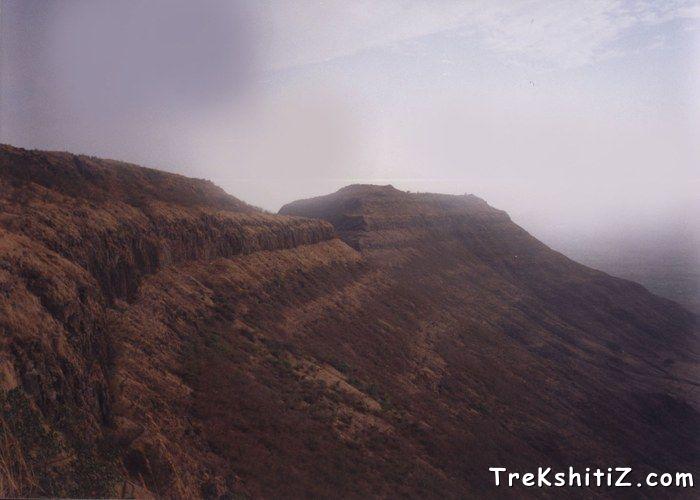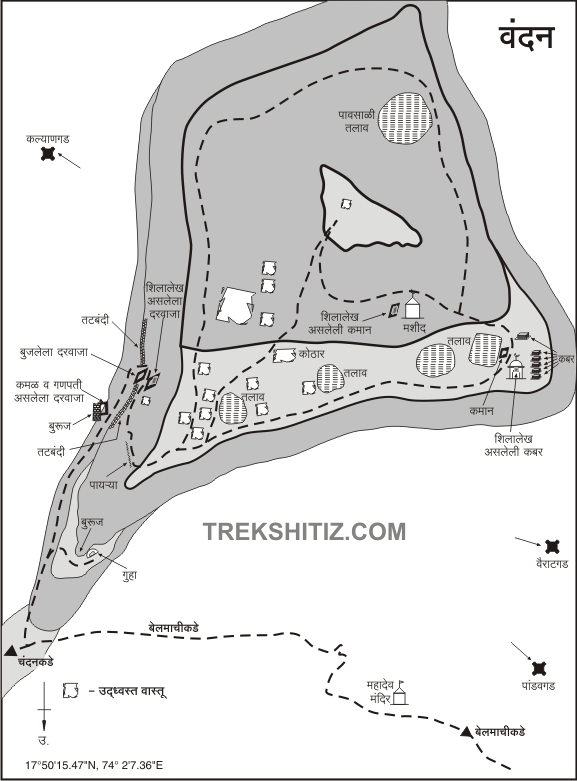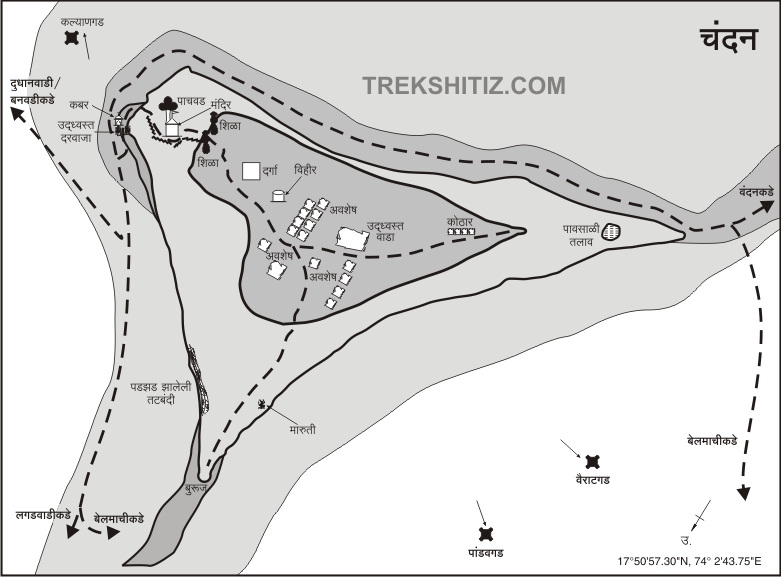| Fort Name : | Alphabetically | RangeWise | DistrictWise | CategoryWise | GradeWise |
| Chandan-Vandan | FortHeight : 3800 feet | ||||||
| Type : Hill forts | Fort Range : Satara | ||||||
| District : Satara | Grade : Easier | ||||||
| Chandan-Vandan, the twin forts, are situated at about 24 kms. from Satara. Cultivation of sugarcane crop in this area has facilitated this area with roads, electricity supply, S.T. bus service and such other basic services. These forts can be easily identified from Pune-Satara route because of their flat plateaus. These forts lie on the boundary of Satara city and Mahabaleshwar region. To the east of these forts lie Jarandeshwar Kalyangad, Bhavani hill, while to the west lie the forts like Vairatgad, Pandavgad. | |||||||
|
|||||||
| History : | |||||||
| According to the evidences of copper-inscriptions(Tamralekh) of 1191-1192 B.C., these forts were built-up by king Bhoj II of Shilahar dynasty. Shivaji Maharaj overpowered Chandan-Vandan along with Kalyangad, Sajjangad, Ajinkyatara during the campaign of Satara in 1673. Later, during the regime of Sambhaji, Amanullah Khan attacked the troop of Maratha soldiers on Chandan-Vandan. 25 horses, 20 guns, 2 ensigns, 1 kettle-drum were lost in the hands of Mughals in this battle. Marathas ruled this region up to 1689 B.C. Afterwards Mughals ruled this fort. In 1707, Chhatrapati Shahu Maharaj won this region during rainy season. In 1752, Dadopant was accompanied by soldiers by Balaji Vishwanath to keep close watch on Tarabai. Later, British ruled over these forts. | |||||||
| Fascinating Spots : | |||||||
| Fort of Chandan: Formerly, the way near the entrance of Chandan was difficult to access. But recently the way has become broader because of mosque situated at that place. There are two bastions at the entrance gate which are presently in a half-demolished state. Approximately about 15 steps ahead of this on the left hand side lies a demolished edifice. There is a banyan tree at the upperside of this structure which is known as ‘Panchvad’, as it is comprised of five banyan trees. There is a temple of lord Shiva near the tree. Both the “Pindis” in the temple are comprised of five “Lingas”. In the month of ‘Shravan’, the fifth month of Hindu year, there is a pilgrimage every year in this temple. Villagers have refurbished the temple. Huge stones, arranged one above the other, can be seen at about 10 steps ahead from the temple. There is a mosque on the fort. A wall-like structure can be seen adjacent to the mosque. Remnants of some structures are found behind the mosque. It seems to be a residential area of those days. An intact bastion can be seen at the north end of the fort. A self-immolation lies on the way to this bastion. There is a ‘Shivalinga’ and a statue of lord Hanumana over the bastion. Three rooms without roofing can be seen at the southern part of the fort. According to villagers, it was a storage room for ammunitions. There is a large quadrangular raised platform, commonly known as SADAR, at the center of the fort. Fort of Vandan: There are two entrance doors for this fort. The first entrance door is sturdy having bastions which are still intact. There is an idol of lord Ganesha on the left bastion. There were about 25 well-constructed steps ahead, which were destroyed in the battle of 1818. The second entrance door has completely tumbled down. Persian inscriptions can be seen on the arch of this door. There are five porches inside this entrance door which together form the L-shape. Rock-slide has blocked the way ahead. Further on there are few steps, downside of which lies a route along which one can traverse around the fort completely. ‘GHANA’, a mechanism where cementitious material is mixed and ground to be used for the construction of structures, can be seen on the lower side of the steps. We reach the fort-top by climbing up about 25 steps. Many dilapidated structures can be seen on the fort. There is a row of demolished houses on the right side. Moving further about 20 of these houses we can see two structures, still undestroyed. The raised platforms on the fort give the indications of the existence of huge houses on the fort. These might have been government offices in those days. There is a storage room on the right side of these platforms, with its roof still intact. Besides there exist a natural lake, which at present has gone dry. A way on the right side beyond this lake takes us towards eastern end of the fort. The way on the left side of the lake takes us to a mosque. Some writings can be seen on the arch of the door which may be Arabian or Persian. A manually constructed lake provided with steps lies beyond the mosque. It might have been used as a lake for bathing. There is a mosque besides this lake. Many tombs can be seen in front of it. There is also a storage room, seen besides this lake. A structure can be seen besides the mosque whose walls are in demolished state. There is a self-immolation inside this structure with the footsteps carved on it. It seems to be a self-immolation of a Brahmin. There is a small hill further on which remnants of many structures can be seen. The ways, which move around the citadel, meet over this hill. | |
| Ways To Reach : | |
| There are common ways to reach Chandan - Vandan. Bhuinj village lies on the Pune-Satara road. Kikali village is at a distance of about 20 k.m. from Bhuinj. S.T. buses ply to Kikali village from Wai as well as Satara. Belmachi village is situated near Kikali village. From here a way heads up to the col between Chandan and Vandan. On the left side lies Chandan while on the right side lies Vandan. Fort of Chandan: There are two ways to reach Chandan: 1) Via Belmachi Village Half an hour will be required to climb the fort from the rock patch in front of the col. One reaches on the southern part of the fort through this route. The other way goes around the fort, with the fort lying on the left side of the way. 2) Via Lagadwadi Village There is a village named Lagadwadi situated ahead of Belmachi. One has to walk across the plains of this village and then cross the headland. The road from Ibrahimpur village meets this way ahead. From here the route goes up to the fort top. It takes about two and half hours to reach the fort of Chandan. Fort of Vandan: Ways to reach the fort: To the right of col, lies the fort of Vandan. This route takes us to the entrance door of the fort within 10 minutes. | |
| Accommodation Facility : | |
| About 30 to 40 persons can be accommodated in the mosque. | |
| Food Facility : | |
| One has to make arrangement for his own food. | |
| Drinking Water Facility : | |
| Drinking water is available on the fort only during rainy season. | |
| Time To Reach : | |
| Approximately about 3 hours will be required to reach the fort of Chandan while about 2 hours are required to climb up the fort of Vandan. |
| Marathi Version |


